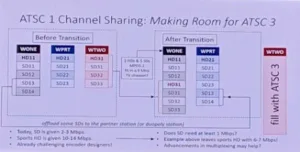Broadcasters, CE companies, equipment manufacturers and service providers met in Washington in late May at the Annual Next Gen TV Conference, to discuss real and anticipated products and services using the new ATSC-3 standard.

Welcoming remarks by newly-appointed ATSC President Madeleine Noland described the hallmark features of the standard, which include bandwidth efficiency, Internet alignment, and “evolvability.” These new characteristics, she said, offer high integration with IP networks, due to the use of IP as a transport layer, as well as a means to prevent obsolescence by using the Bootstrap Signal that allows for new transmission modes. The standard also presents new B2B opportunities, such as with mobile advertising in transportation vehicles.

¶ Myra Moore, of Digital Tech Consulting, chaired a panel regarding the ATSC 1.0-to- 3.0 transition, and looked at ways to “Encourage Market Collaboration.” Dave Folsom, of Pearl TV, says that there is a growing effort aimed at implementing ATSC-3 in the Pearl member stations, comprising more than 300 TV stations that are network-affiliated with eight of the largest broadcasting companies in America.
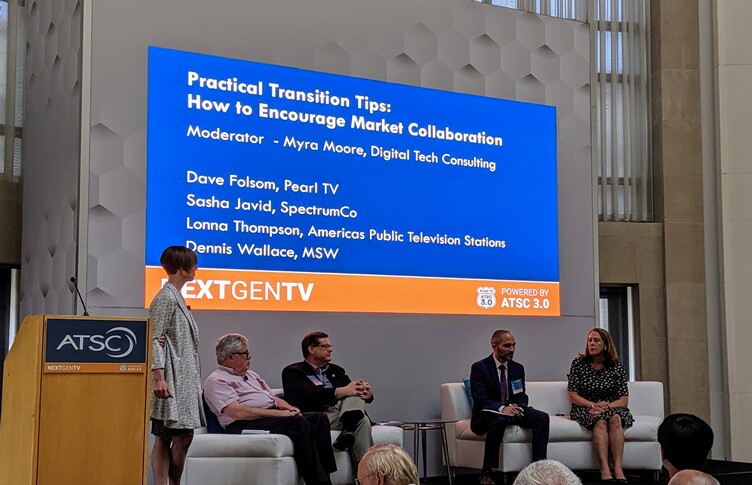
Lonna Thompson, America’s Public TV Stations, explained that APTS is serving as a public station interface to the FCC, and is ensuring that the Federal rules for the ATSC-3 standard are used to best serve TV viewers. Dennis Wallace, of Meintel, Sgirgnoli & Wallace, said that ATSC-3 deployment requires a “coalition of stations,” and emphasizes the need for “lighthouse stations” – pilot stations in each market that will work together, using one transmitter to carry all ATSC 1.0 services and other transmitters to carry ATSC 3.0. Dave Folsom, of Pearl TV, said that the technical part of this cooperation is straightforward, but legal matters present the bigger challenge; program-licensing issues, for example, were a surprise, but negotiations succeeded in Phoenix, where broadcasters have already built the first collaborative single-market effort to plan for and implement a transition to Next Gen TV (see our earlier NAB story).
Spectrum aggregator, SpectrumCo, already has a core of cooperating stations, according to Folsum, but what about others? “Do it simultaneous with [the FCC spectrum] repack,” he suggests, to which Wallace adds, “Duopoly helps, and the repack can be done simultaneously with an upgrade to 3.0,” saving time and expense, since transmission facilities already need an upgrade. He also reminded broadcasters that the MVPDs (multichannel video-programming distributors, i.e., cable and satellite providers) will require notification (and some degree of negotiation of rights), and at the same time, ATSC-3 can offer opportunities that OTT (over-the-top) can’t exclusively provide.
However, Sasha Javid of SpectrumCo cautions that “cost sharing gets dicey,” as there may be push back [e.g., FCC and FTC] when competing interests cooperate.
In a discussion regarding the newly-defined ATSC-3 Commercial TV License application process, Evan Morris of the FCC Media Bureau said that Next Gen TV applications qualify for expedited processing if the ATSC 1.0 simulcast coverage meets 95% coverage overlap threshold based on predicted population. This new process should provide a accelrated way of getting an ATSC-3 station on-air. All licensed full power, Class A, LPTV, and TV Translator stations were permitted to start filing on May 28, 2019.
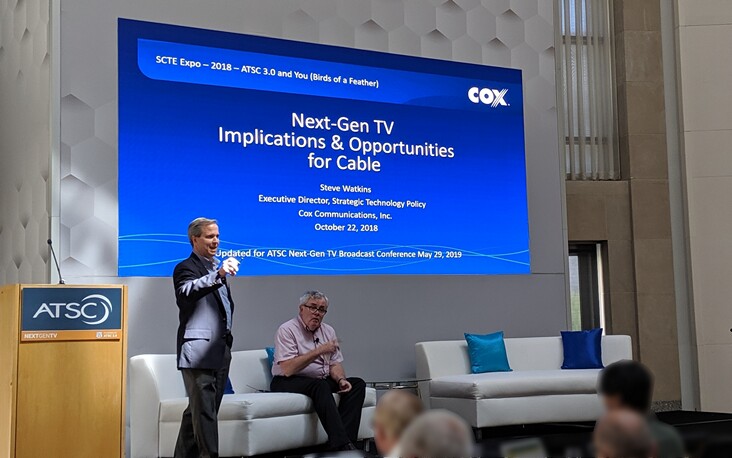
Steve Watkins, Cox Media, gave a spirited talk on working with multichannel video providers to launch ATSC 3. The ATSC 3 signal is different than the ATSC 1.0 signal, he said, and not only will there be different formats and resolutions, and different bandwidths per over-the-air channel, but over-the-air signals are different from fiber/network feeds, and the ATSC 3 signal may undergo regular change, esp. during initial launch.
The user interface will be present its own set of conditions, too, and will need to be designed carefully to avoid customer confusion – with the hopeful goal of minimizing (or eliminating) multiple remote controls.
John Hane of SpectrumCo moderated a session on encoding that was aimed at “Getting the Most Out of Bandwidth.” He started out by describing scenarios that demonstrate some of the issues to be addressed: channel-sharing among broadcasters, for instance, will define situations where different broadcasters and different programs may have varying bandwidth needs throughout a broadcast day. Historically, we have had statistical multiplexers balance the loads within one broadcaster’s transmission, but that will now change, when broadcasters share channels – and not only dynamically, but also statistically over time, he pointed out.
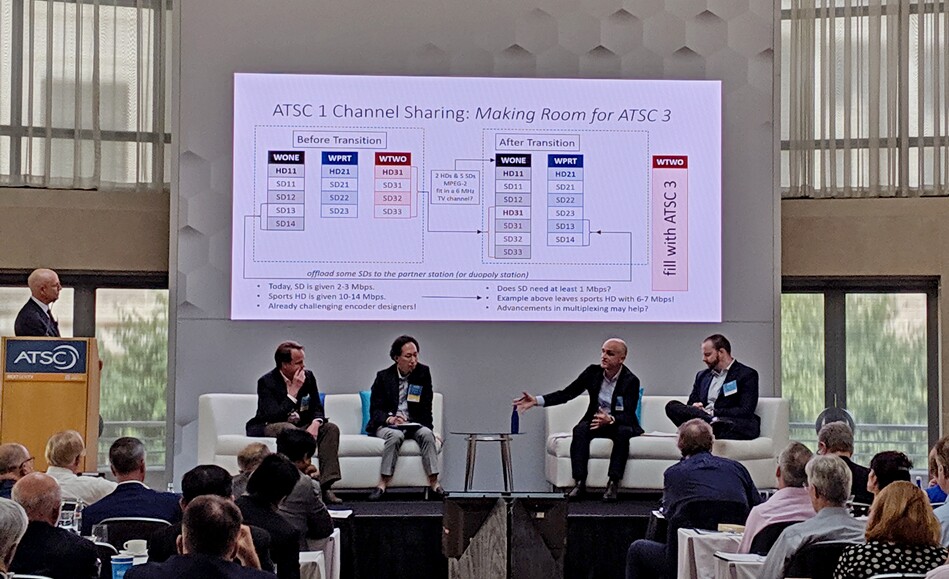
Winston Caldwell, of Fox, raised some questions that will need to be answered, such as, “How do you channel-clear, and then slot-in new services?” Jean Macher of Harmonic said that inter-company agreements will need to handle bitrates that could vary over time, and for that matter, just how will a bitrate be defined, especially when considering variable bit rates and statistical multiplexing. From a practical sense, it’s tricky to define quality, too, as machine algorithms and people each have limitations. And UHD could be sent in a hybrid manner, with different elements traveling over-the-top, further complicating bandwidth management.
Day 2
Madeleine Noland started day two of the conference by outlining some of the initiatives already underway at ATSC, including broadcaster and public education, usage guidelines, equipment plugfests, conformance testing, the Project Implementation Planning Teams and Implementation Teams (roughly a parallel to the DVB Commercial Module), and the proposed ITU adoption of the ATSC 3.0 digital broadcast standard for use by all countries in the world. Looking to the future, Noland described emerging efforts to facilitate usage of new features and interfaces, as well as exploring new sectors like automotive applications, international IP data delivery networks, and synergy with 5G, 4G, and OTT networks.
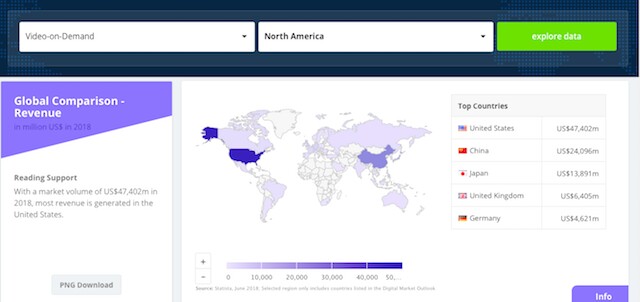
Exploring automotive applications of ATSC 3, NAB CTO Sam Matheny noted that the largest swath of wireless spectrum is currently held by TV broadcasters, especially in the low band below 3 GHz.
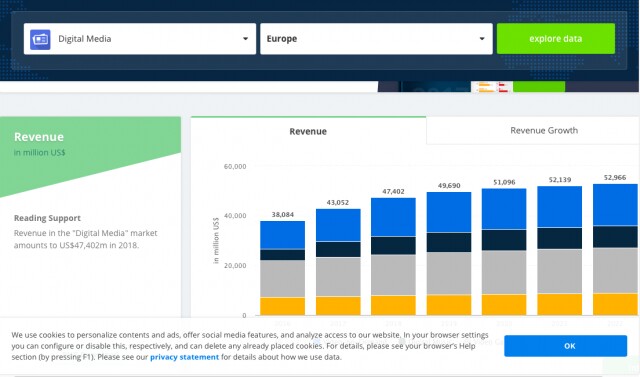
Bryan Biniak, CEO of Connected Travel, described a number of visionary business models aimed at monetizing data from vehicles. Telematics, AI and Machine Learning bring context and personalization to every car ride, he says, and while some of this is currently exploited through a cellular connection, it is implied that ATSC-3 could be used in this ecosystem as well, with its mobile broadcast capabilities.
Branding and Conformance Plans
Branding and Conformance Plans for ATSC 3 were discussed in a panel led by Lynn Claudy,
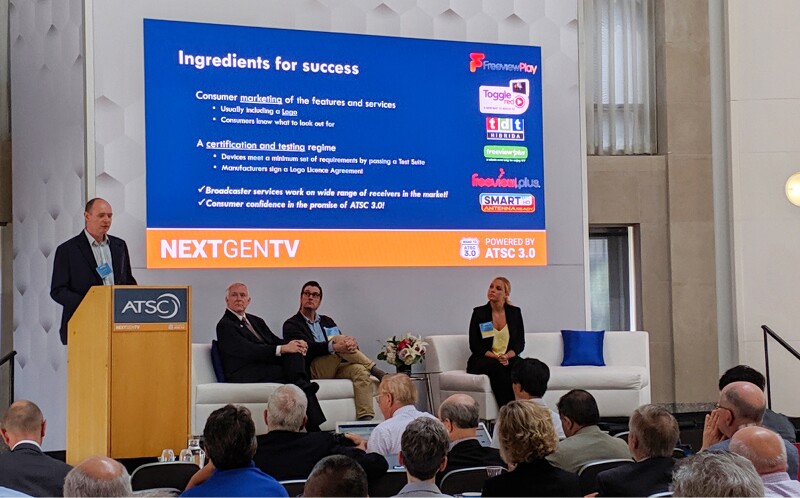
VP of Technology for NAB. Bob Campbell of Eurofins described how consumer marketing of features and services usually includes a logo, so consumers know a product’s capabilities, and that requires a certification and testing regime. Typically, devices must meet a minimum set of requirements by passing a Test Suite, and manufacturers sign a Logo License Agreement attesting to the certification. (ATSC has formed a Conformance Implementation Team that provides a venue to scope and plan for a formal conformance test program for both emission and reception. The implementation team is not expected to perform device or system testing.)
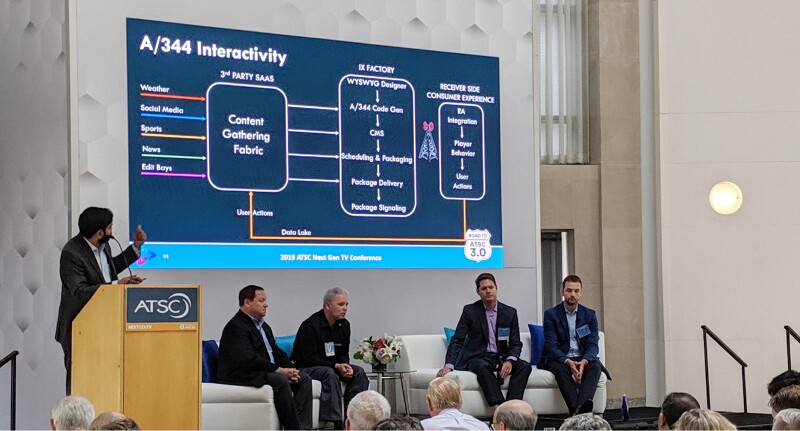
Chandra Koduri, Gaian Solutions, led a session on How Broadcasters Can Prepare for ATSC 3.0 Operations. In addition to the customary equipment and deployment field trial, he outlined how business service trials will be a key component, along with a refinement of new work flows, especially with interactive services. Jim DeChant, News, Press & Gazette, suggested that an integrated app “would make multiple remotes unnecessary” (but a key question then becomes, who owns and runs the app?)
Nicole Meighan, of Magid Research, provided a number of “Consumer Viewpoints on Next Gen TV, the result of several consumer surveys developed by the company.
The ATSC 3 signal could increase broadcast viewing overall for both Broadcast Viewers and Cord-Cutters/Cord-Nevers, they found, with 91% saying they are either “interested” or “very interested” in using a service like ATSC 3.0. And Early Adopters were especially interested in paying more for devices that provide ATSC 3.0 functionality. Among the features drawing wide support, she said, are Customization Settings based on preferences, such as creating favorite channel lists and setting program reminders.

Richard Friedel of Fox led a session examining “How ATSC 3.0 Drives Innovation.” Champions of that vision included Ed Busby, of Tegna, suggesting that ATSC 3 could inspire an apps ecosystem like that pioneered by Apple. Chandra Koduri of Gaian said that data apps could be “multipliers over linear tv,” and Glenn Reitmeier, of NBC- Universal, amplified on those concepts, saying that the needed “economy of scale could come from a national footprint” of ATSC 3. Brett Jenkins of Nexstar went further, predicting that ATSC 3 business models could return a “retransmission-consent” type of income, if there could be some kind of vertical integration such as that which made TV successful years ago for RCA. Reitmeier, a former RCA engineer and executive, put a historical perspective on that, observing that
“receivers drove the market [back then], but now content – once a loss leader – drives revenue today.” And pushing back on a question regarding ATSC 3 on cell phones, Jenkins responded that “phones are valuable but not necessary,” for ATSC 3 to succeed.

Other sessions at the conference included Public Broadcasting Preparations and Emergency Alerting. ¶ The conference closed with a presentation of awards. Industry veteran Adam Goldberg received the 2019 Bernard J. Lechner Outstanding Contributor Award, ATSC’s highest technical honor. Goldberg chairs the S36 Specialist Group on ATSC 3.0 Security. The newly-created ATSC Industry Leadership Medal was presented to recently-retired ATSC President Mark Richer. The Medal recognizes an individual or team that demonstrates exemplary leadership in advancing the mission of ATSC, and epitomizes the vision, tenacity and leadership qualities that were the hallmark of Richer’s leadership.
 Mark Richer with Lynn Claudy and Madeleine Noland. Photo courtesy of ATSC.
Mark Richer with Lynn Claudy and Madeleine Noland. Photo courtesy of ATSC.

